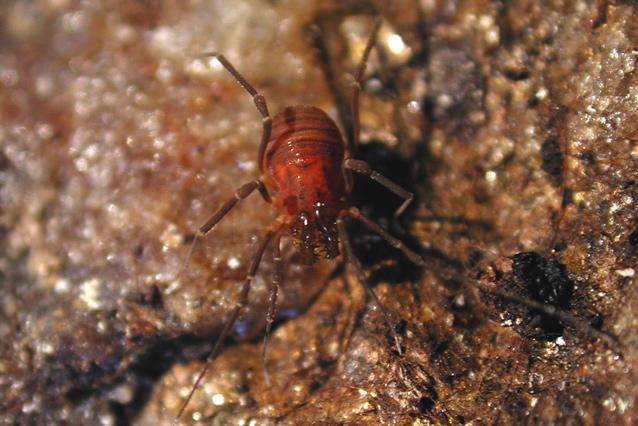- Phalangodidae
image_caption = "Bishopella laciniosa "
image_width = 250px
regnum =Animal ia
phylum =Arthropoda
classis =Arachnida
ordo =Opiliones
subordo =Laniatores
infraordo =Grassatores
superfamilia =Phalangodoidea
familia = Phalangodidae
familia_authority = Simon, 1879
subdivision_ranks = Genera
subdivision = See text for list.
synonyms =Paralolidae Kratochvíl, 1958
Lolinae Kratochvíl, 1958The Phalangodidae are a family of
harvestman with about 20 genera and more than 100 described species, distributed in the Holarctic Region.It is not to be confused with the harvestman family
Phalangiidae , which is in thesuborder Eupnoi .Name
The name of the type genus "Phalangodes" is derived from
Ancient Greek "phalanx", a line of soldiers in formation. This probably refers to the rows ofpedipalp al spines.aut|Ubick, Darrell (2007): Phalangodidae Simon, 1879. In: Pinto-da-Rocha "et al." 2007: 217ff]Description
Body length ranges from less than one to about three millimeter. The pedipalps are armed with large spines. While some species have short legs (about twice the body length), others have legs eight times the body length. Most species are yellowish to orange brown. Cave-dwelling species are depigmented.
Distribution
More than two thirds of the species occur in the western
Nearctic , especially inCalifornia with about 50 species in four endemic genera. About ten species are known from the eastern Nearctic. Few occur in thePalearctic , with one species each in theCanary Islands andJapan , and about 20 species in theMediterranean .Relationships
The family seems to be largely
monophyletic , with the exceptions of a few genera like "Guerrobunus" and "Glennhuntia". Although the relationship of Phalangodidae to otherGrassatores is curretly unresolved, at seems that the family is relatively basal inside the Grassatores.Genera
For a list of all currently described species, see the
List of Phalangodidae species .* "
Ausobskya " Martens, 1972 —Greece (4 species)
* "Banksula " Roewer, 1949 —California (10 species)
* "Bishopella " Roewer, 1927 — southeastern US (2 species)
* "Calicina " Ubick & Briggs, 1989 — California (25 species)
* "Crosbyella " Roewer, 1927 — southeastern US (5 species)
* "Glennhuntia " Shear, 2001 — western Australia (1 species) "(probably misplaced)"
* "Guerrobunus " Goodnight & Goodnight, 1945 —Mexico (3 species) "(probably misplaced)"
* "Haasus " Roewer, 1949 — ( species)
* "Lola" Kratochvíl, 1937 — Israel (1 species)
* "Maiorerus " Rambla, 1993 —Canary Islands (1 species)
* "Microcina " Briggs & Ubick, 1989 — California (6 species)
* "Paralola " Kratochvíl, Balat & Pelikan, 1958 — Bulgaria (1 species)
* "Phalangodes " Tellkampf, 1844 — Kentucky, Cuba? (2 species) ("1 species possibly misplaced")
* "Phalangomma " Roewer, 1949 — Virginia (1 species) "(probably misplaced)"
* "Proscotolemon " Roewer, 1916 —Japan (1 species)
* "Ptychosoma " Sørensen, 1873 — Spain, Italy, North Africa (2 species)
* "Scotolemon " Lucas, 1860 — Mediterranean (13 species)
* "Sitalcina " Banks, 1911 — California (9 species)
* "Texella " Goodnight & Goodnight, 1942 — Texas, California, Oregon, New Mexico (28 species)
* "Tolus " Goodnight & Goodnight, 1942 —Tennessee (1 species)
* "Undulus " Goodnight & Goodnight, 1942 —Alabama (1 species)
* "Wespus " Goodnight & Goodnight, 1942 —Arkansas (1 species)Footnotes
References
*'s Biology Catalog: [http://insects.tamu.edu/research/collection/hallan/Acari/Family/Phalangodidae.txt Phalangodidae]
* (eds.) (2007): Harvestmen - The Biology of Opiliones. "Harvard University Press" ISBN 0-674-02343-9
Wikimedia Foundation. 2010.

